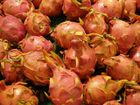Hylocereus
Hylocereus (A. Berger) Britton & Rose
| Order | Caryophyllales |
|---|---|
| Family | Cactaceae |
| Distribution |
Central America, Antilles and northern South America |
ca. 16
Biology
- Scandent or epiphytic shrubs
- Stems often to 5 m or more, usually 3-winged or angled, segmented.
- Flower usually very large, funnelform, nocturnal, white or rarely red.
- Fruit large, globose, ovoid or oblong, fleshy, with broad scales.
After Barthlott & Hunt in Kubitzki, 1993. In this treatment, Selenicereus is distinguished as having a pericarpel without conspicuous triangular scales. After Bauer (2003), Hylocereus includes the Salmdyckia group (H. extensus, H. megalanthus, H. setaceus and H. tricae), which has spines on pericarpel and fruit.
Popular names
The classification of pitahayas has been so confused up to now that it is often unclear to which species popular names really apply. Some sources are reproduced here.
Classification
Hylocereus (A. Berger) Britton & Rose (1909)
synonyms
- Cactus L. (1753) pro parte
- Cereus subg. Hylocereus A. Berger (1905)
- Wilmattea Britton & Rose (1920)
Sometimes included in: Selenicereus (A. Berger) Britton & Rose (1909)
- Images to identify
Species
- Hylocereus calcaratus (F. A. C. Weber) Britton & Rose
- Hylocereus costaricensis (F. A. C. Weber) Britton & Rose : pulp red-purple.
- Hylocereus guatemalensis (Eichlam) Britton & Rose
- Hylocereus lemairei (Hook.) Britton & Rose
- Hylocereus ocamponis (Salm-Dyck) Britton & Rose
- Hylocereus polyrhizus (F. A. C. Weber) Britton & Rose
- Hylocereus triangularis (L.) Britton & Rose : fruit yellow.
- Hylocereus trigonus (Haw.) Saff. : pulp pinkish-white.
- Hylocereus undatus (Haw.) Britton & Rose : pulp white.
Salmdyckia group
- Hylocereus megalanthus (K. Schum. ex Vaupel) Ralf Bauer : fruit yellow with spiny tubercles (not scales), pulp white or purple.
- Hylocereus setaceus (Salm-Dyck ex DC.) Ralf Bauer
Hybrids are known, such as Hylocereus costaricensis x undatus (with red pulp).
References
- Bauer, R., 2003. A synopsis of the tribe Hylocereeae F. Buxb. Cactaceae Systematics Initiatives, 17: 3-63.
- Barthlott, W. & Hunt D.R., 1993. Cactaceae. in Kubitzki K. (ed.), The families and genera of vascular plants. vol. 2. Flowering plants. Dicotyledons. Magnoliid, Hamamelid and Caryophyllid Families. Berlin, Heidelberg, New-York, Springer. pp. 161-196.
- Le Bellec, Fabrice, 2011. Les pitahayas (Hylocereus spp.). jaunes, rouges... quelques clés pour mieux les connaître et les reconnaître. Fruitrop, 195 : 29-33.
- Le Bellec, Fabrice & Vaillant, F., 2011. Pitaya, Pitahaya (Hylocereus spp.). In Yahia Elhadi M. (ed.), Postharvest Biology and Technology of Tropical and Sub-Tropical Fruits, vol. 4: Mangosteen to white sapote. Cambridge, UK, Woodhead Publishing Limited, 247-271.
- Mizrahi, Yosef, Nerd, Avinoam et Nobel, Park S., 1997. Cacti as crops. Horticultural Reviews, 18 : 291-319, 4 pl. coul.
- Nerd, Avinoam & Mizrahi, Yosef, 1997. Reproductive biology of cactus fruit crops. Horticultural Reviews, 18 : 321-346.
- Tel-Zur, N., Abbo, S., Bar-Zvi, D. & Mizrahi, Y., 2004. Genetic relationships among Hylocereus and Selenicereus vine cacti (Cactaceae): evidence from hybridization and cytological studies. Ann. Bot. (Lond.), 94(4): 527-34.
- Weiss, J., Scheinvar, L. & Mizrahi, Y., 1995. Selenicereus megalanthus (the yellow pitaya): a climbing cactus from Colombia. Cactus Succulent J., 67 : 280-283.
Links
GRIN page 12 species in GRIN.





